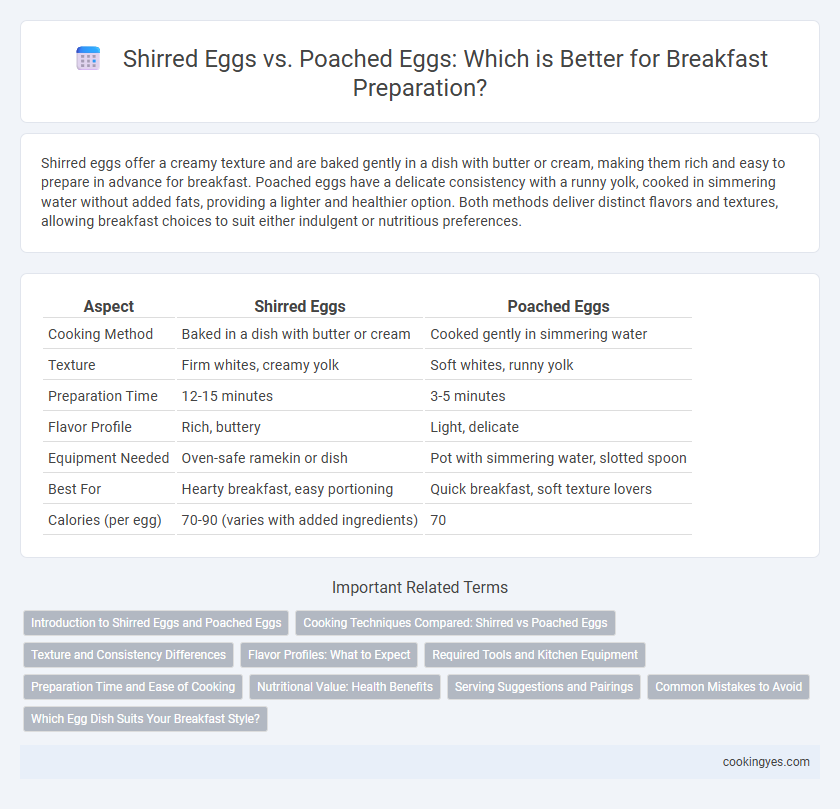Shirred eggs offer a creamy texture and are baked gently in a dish with butter or cream, making them rich and easy to prepare in advance for breakfast. Poached eggs have a delicate consistency with a runny yolk, cooked in simmering water without added fats, providing a lighter and healthier option. Both methods deliver distinct flavors and textures, allowing breakfast choices to suit either indulgent or nutritious preferences.
Table of Comparison
| Aspect | Shirred Eggs | Poached Eggs |
|---|---|---|
| Cooking Method | Baked in a dish with butter or cream | Cooked gently in simmering water |
| Texture | Firm whites, creamy yolk | Soft whites, runny yolk |
| Preparation Time | 12-15 minutes | 3-5 minutes |
| Flavor Profile | Rich, buttery | Light, delicate |
| Equipment Needed | Oven-safe ramekin or dish | Pot with simmering water, slotted spoon |
| Best For | Hearty breakfast, easy portioning | Quick breakfast, soft texture lovers |
| Calories (per egg) | 70-90 (varies with added ingredients) | 70 |
Introduction to Shirred Eggs and Poached Eggs
Shirred eggs, also known as baked eggs, are cooked in a shallow dish in the oven, resulting in a creamy texture with a slightly firm white and runny yolk. Poached eggs are gently cooked by simmering them in water, producing a delicate, smooth exterior and fully tender whites surrounding a soft yolk. Both methods offer nutritious breakfast options with distinct textures and preparation styles ideal for varied culinary preferences.
Cooking Techniques Compared: Shirred vs Poached Eggs
Shirred eggs require baking in a flat-bottomed dish with butter or cream, resulting in a creamy, custard-like texture, while poached eggs involve gently cooking eggs in simmering water for a delicate, tender white with a runny yolk. Shirred eggs allow for easy seasoning and ingredient additions during baking, whereas poached eggs demand precise timing and water temperature control to maintain shape and texture. Both techniques emphasize moisture retention but differ significantly in preparation methods and final presentation, affecting flavor infusion and consistency.
Texture and Consistency Differences
Shirred eggs have a creamy, custard-like texture due to slow baking in a dish, resulting in a firmer yet tender consistency that holds shape well. Poached eggs feature a delicate, silky texture with a runny yolk encased in a smooth, softly set white, offering a lighter mouthfeel. The difference in cooking methods creates distinct textures: shirred eggs are denser and more uniform, while poached eggs emphasize contrast between the tender white and fluid yolk.
Flavor Profiles: What to Expect
Shirred eggs deliver a rich, creamy texture with buttery undertones due to gentle baking, enhancing the yolk's natural sweetness. Poached eggs offer a delicate, tender consistency with a clean, mild flavor that highlights the fresh egg taste without added fat. Both methods preserve egg freshness, but shirred eggs provide a more comforting, custard-like experience, while poached eggs bring lightness and subtlety to breakfast.
Required Tools and Kitchen Equipment
Shirred eggs require an oven-safe dish such as a ramekin and a baking tray, making an oven or toaster oven essential for cooking. Poached eggs demand a deep saucepan filled with simmering water and often a slotted spoon to gently lift the eggs without breaking. Both methods rely on precise heat control, but shirred eggs involve baking equipment while poached eggs need stovetop tools.
Preparation Time and Ease of Cooking
Shirred eggs typically require about 15-20 minutes to bake in the oven, making them slightly longer to prepare compared to poached eggs, which take only 3-5 minutes on the stovetop. Poached eggs demand careful attention to water temperature and timing to achieve the perfect consistency, whereas shirred eggs allow for more hands-off cooking by simply baking in a dish. For quick and easy breakfast preparation, poached eggs are ideal, but shirred eggs offer a more forgiving method with minimal active cooking time.
Nutritional Value: Health Benefits
Shirred eggs retain more of their natural nutrients due to gentle baking, preserving protein quality and essential vitamins like B12 and D. Poached eggs, cooked without added fat, offer lower calorie content and maintain delicate antioxidants, supporting heart health. Both methods provide high-quality protein and essential nutrients, but shirred eggs may contain slightly more calories depending on added ingredients.
Serving Suggestions and Pairings
Shirred eggs, baked with cream or butter, pair excellently with toasted English muffins and smoked salmon, offering a rich, comforting breakfast experience. Poached eggs, with their delicate texture and runny yolk, complement fresh avocado toast and sauteed spinach, enhancing light and healthy morning meals. Both styles serve well atop grain bowls or with crispy bacon for balanced flavors and satisfying protein options.
Common Mistakes to Avoid
Common mistakes when preparing shirred eggs include using excessive heat, which can cause uneven cooking and rubbery texture, and neglecting to butter the baking dish, leading to sticking. For poached eggs, avoiding water that is not at a gentle simmer prevents the egg white from dispersing, while overcooking results in tough, dry yolks. Proper temperature control and timing are essential to achieve the ideal consistency and texture for both shirred and poached eggs.
Which Egg Dish Suits Your Breakfast Style?
Shirred eggs offer a creamy, baked texture ideal for those who prefer a hands-off breakfast with rich, custard-like yolks, while poached eggs deliver a delicate, tender white and runny yolk perfect for a light, low-fat meal. Shirred eggs suit a leisurely morning as they require baking time and are often paired with cheese or cream, enhancing their savory depth. Poached eggs fit active breakfast routines where quick, health-conscious preparation is key, often served on toast or with vegetables for a balanced start.
Shirred eggs vs Poached eggs for breakfast preparation Infographic

 cookingyes.com
cookingyes.com